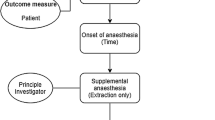Abstract
Aim
The present study compared the efficacy of inferior alveolar nerve block (IANB) and local infiltration with 4% articaine combined with IANB using 2% lignocaine in mandibular third molar surgery.
Materials and Methods
This in-vivo study analysed 90 patients undergoing third molar surgery, divided into three groups. The appropriate groups received 4% articaine hydrochloride with 1:100,000 epinephrine and 2% lignocaine hydrochloride with 1:100,000 epinephrine. Various parameters, including anaesthesia duration, onset, surgery duration, postoperative analgesia duration, and intra-operative pain, were assessed using the Heft-Parker VAS. The collected data was evaluated for statistical analysis.
Results
In this study, articaine demonstrated a shorter onset of action and longer analgesia duration when compared to lidocaine. Articaine infiltration provided an average analgesia duration of 32.37 + 8.9 min during surgery, surpassing articaine IANB and lignocaine IANB. Although the duration of anaesthesia and postoperative anaesthesia showed no significant differences, articaine infiltration had a slightly longer duration of action. Intra-operative pain assessment revealed that 50% of individuals in the articaine IANB group reported no pain.
Conclusion
Articaine infiltrations are highly effective for anaesthesia in mandibular third molar extraction, surpassing other local anaesthetics. It is a superior alternative to regional nerve blocks in minor oral surgeries.



Similar content being viewed by others
References
Li Z, Yang M, Liao T, Zhou Y, Yue H, Piao Z, Zhou L (2020) Combined inferior alveolar nerve block anaesthesia and local infiltration anaesthesia in extraction of impacted mandibular third molars: a randomised controlled trial. Br Dent J, pp 1–6. https://doi.org/10.1038/s41415-020-2002-z.
Kim C, Hwang KG, Park CJ (2018) Local anesthesia for mandibular third molar extraction. J Dent Anesth Pain Med 18(5):287–294. https://doi.org/10.17245/jdapm.2018.18.5.287
Im TY, Hwang KG, Park CJ, Kim KS, Oh Y, Han JY, Shim KS (2010) Randomized, double-blind, comparative clinical trial on the efficacy of 4% articaine and 2% lidocaine in inferior alveolar nerve block anesthesia. J Korean Dent Soc Anesthesiol 10(1):1–6. https://doi.org/10.17245/jkdsa.2010.10.1.1.
Sierra Rebolledo A, Delgado Molina E, BeriniAytés L, Gay EC (2007) Comparative study of the anesthetic efficacy of 4% articaine versus 2% lidocaine in inferior alveolar nerve block during surgical extraction of impacted lower third molars. Med Oral Patol Oral Cir Bucal 12(2):139–144 (PMID: 17322803)
Balakrishnan K, Ebenezer V, Dakir A, Kumar S, Prakash D (2015) Bupivacaine versus lignocaine as the choice of locallanesthetic agent for impacted third molar surgery a review. J Pharm Bioallied Sci 7:S230. https://doi.org/10.4103/975-7406.155921.
Yapp KE, Hopcraft MS, Parashos P (2011) Articaine: a review of the literature. Br Dent J 210(7):323–329. https://doi.org/10.1038/sj.bdj.2011.240
Malamed SF (2016) Handbook of local anesthesia-e-book, 7th edn. Elsevier Health Sciences, Amsterdam.
Khalil H (2014) A basic review on the inferior alveolar nerve block techniques. Anesthesia Essays Res 8(1):3. https://doi.org/10.4103/0259-1162.128891.
Lima JL, Dias-Ribeiro E, Ferreira-Rocha J, Soares R, Costa FW, Fan S, Sant'Ana E (2013) Comparison of buccal infiltration of 4% articaine with 1: 100,000 and 1: 200,000 epinephrine for extraction of maxillary third molars with pericoronitis: a pilot study. Anesthesia Progress 60(2):42–45. https://doi.org/10.2344/0003-3006-60.2.42.
Osunde O, Saheeb B, Bassey G (2014) Indications and risk factors for complications of lower third molar surgery in a Nigerian teaching hospital. Ann Med Health Sci Res 4(6):938–942. https://doi.org/10.4103/2141-9248.144919
Varghese G (2021) Management of impacted third molars. Oral Maxillofacial Surg Clin, pp 299–328.
Acham S, Truschnegg A, Rugani P et al (2019) Needle fracture as a complication of dental local anesthesia: recommendations for prevention and a comprehensive treatment algorithm based on literature from the past four decades. Clin Oral Invest 23:1109–1119. https://doi.org/10.1007/s00784-018-2525-8
Flanagan DF (2015) The effectiveness of articaine in mandibular facial infiltrations. Local Reg Anesth 18:1–6. https://doi.org/10.2147/LRA.S94647
Malamed SF, Gagnon S, Leblanc D (2000) Efficacy of articaine: a new amide local anesthetic. J Am Dent Assoc 131(5):635–642.https://doi.org/10.14219/jada.archive.2000.0237.
Aggarwal V, Singla M, Miglani S, Kohli S (2019) Efficacy of articaine versus lidocaine administered as supplementary intraligamentary injection after a failed inferior alveolar nerve block: a randomized double-blind study. J Endod 45(1):1–5. https://doi.org/10.1016/j.joen.2018.09.012
Thakare A, Bhate K, Kathariya R (2014) Comparison of 4% articaine and 0.5% bupivacaine anesthetic efficacy in orthodontic extractions: prospective, randomized crossover study. Acta Anaesthesiol Taiwan 52(2):59–63.https://doi.org/10.1016/j.aat.2014.04.006.
Mittal J, Kaur G, Mann HS, Narang S, Kamra M, Kapoor S, Sindhi M, Kataria R (2018) Comparative study of the efficacy of 4% Articaine vs 2% Lidocaine in surgical removal of bilaterally impacted mandibular third molars. J Contemp Dent Pract 19(6):743–748 (PMID: 29959306)
Author information
Authors and Affiliations
Corresponding author
Additional information
Publisher's Note
Springer Nature remains neutral with regard to jurisdictional claims in published maps and institutional affiliations.
Rights and permissions
Springer Nature or its licensor (e.g. a society or other partner) holds exclusive rights to this article under a publishing agreement with the author(s) or other rightsholder(s); author self-archiving of the accepted manuscript version of this article is solely governed by the terms of such publishing agreement and applicable law.
About this article
Cite this article
Selvam, T.V.N., Vaithilingam, Y., Arumugam, B. et al. Revolutionising Third Molar Surgery: Unveiling the Superiority of Articaine and Lignocaine in Nerve Block Techniques. A Ground-breaking Triple-Blind, Randomised Clinical Trial. J. Maxillofac. Oral Surg. (2024). https://doi.org/10.1007/s12663-023-02107-y
Received:
Accepted:
Published:
DOI: https://doi.org/10.1007/s12663-023-02107-y




